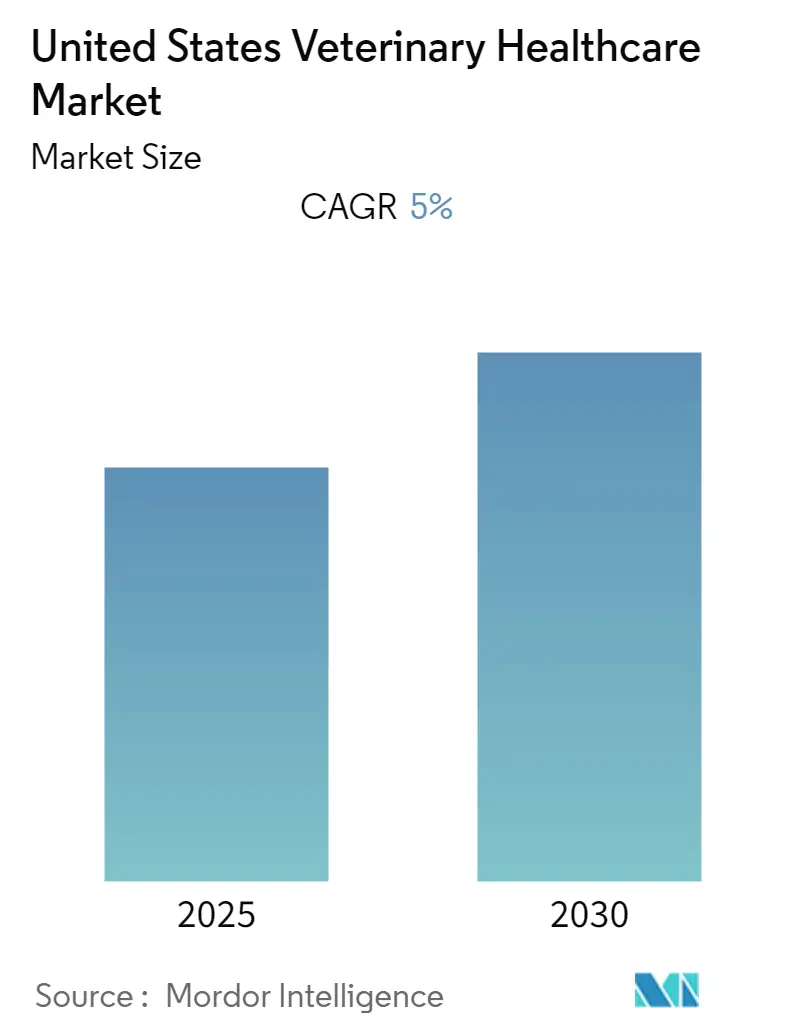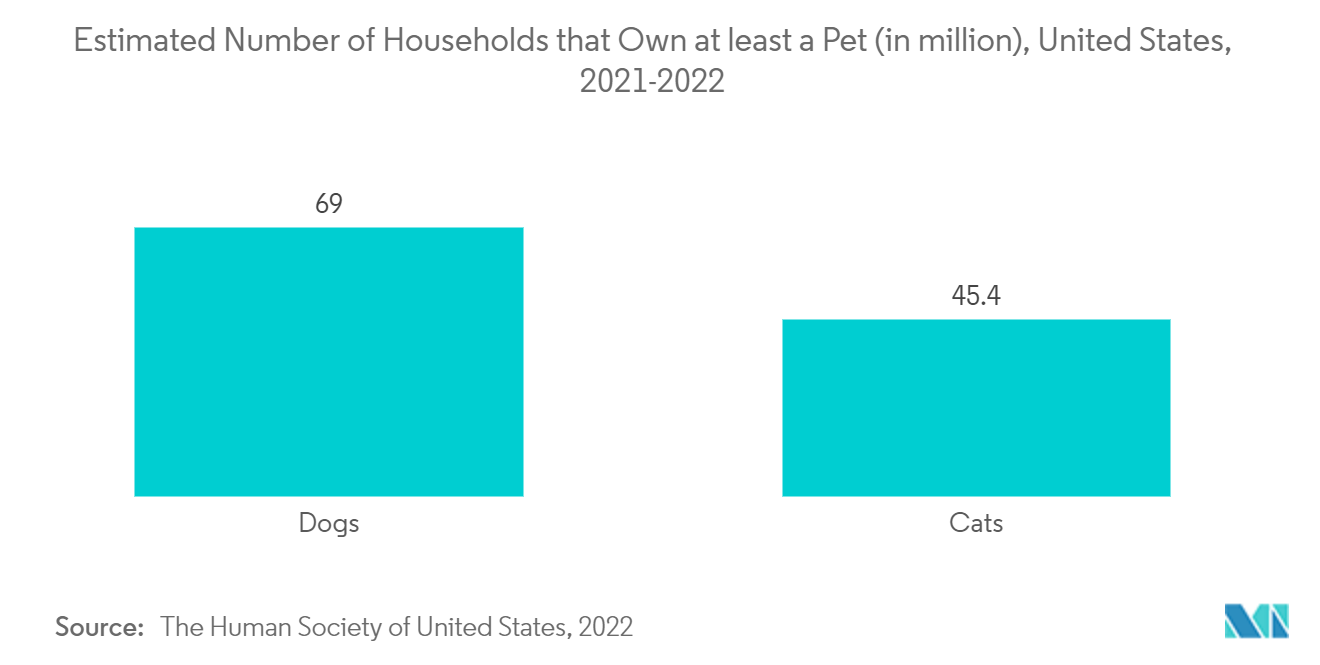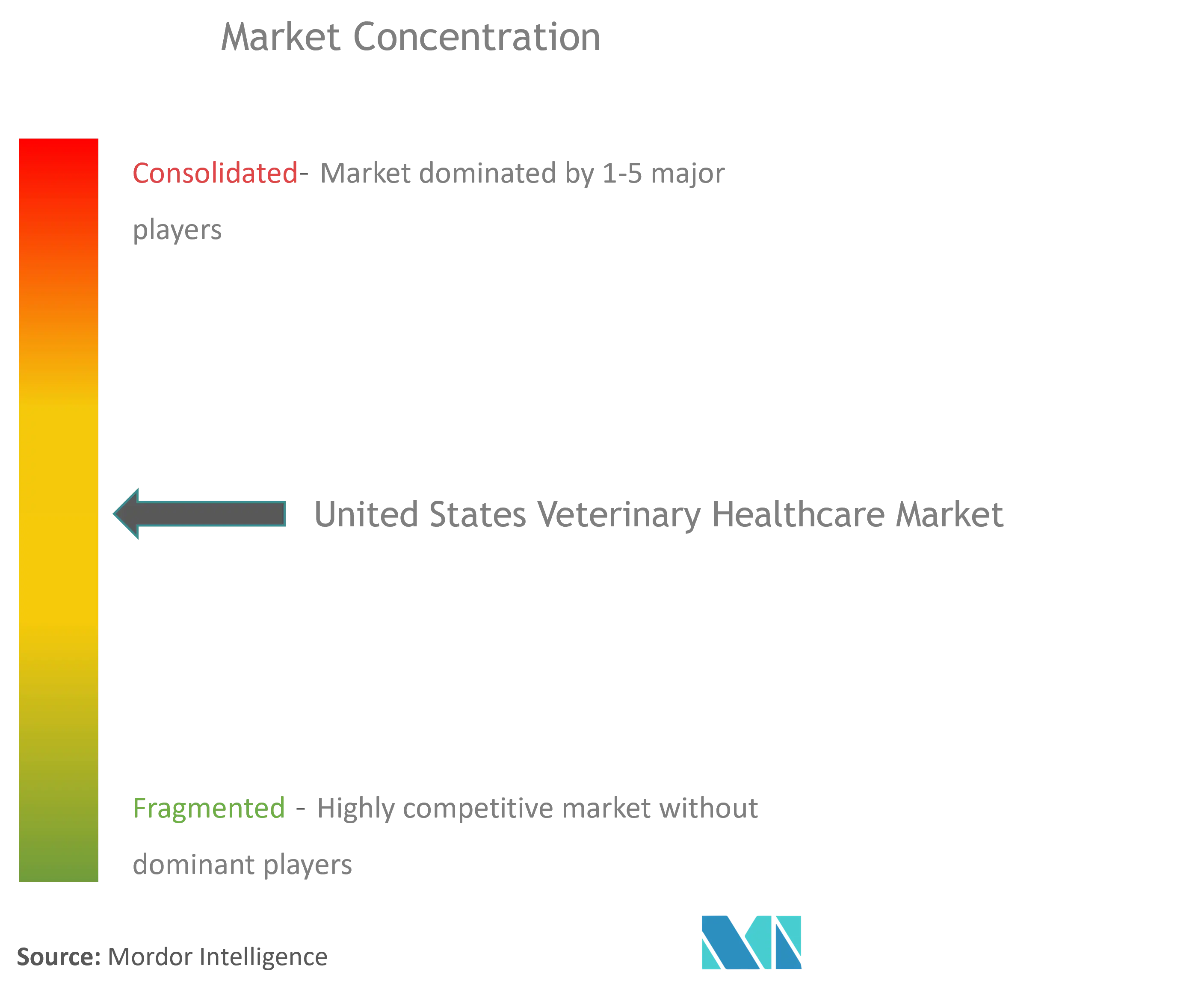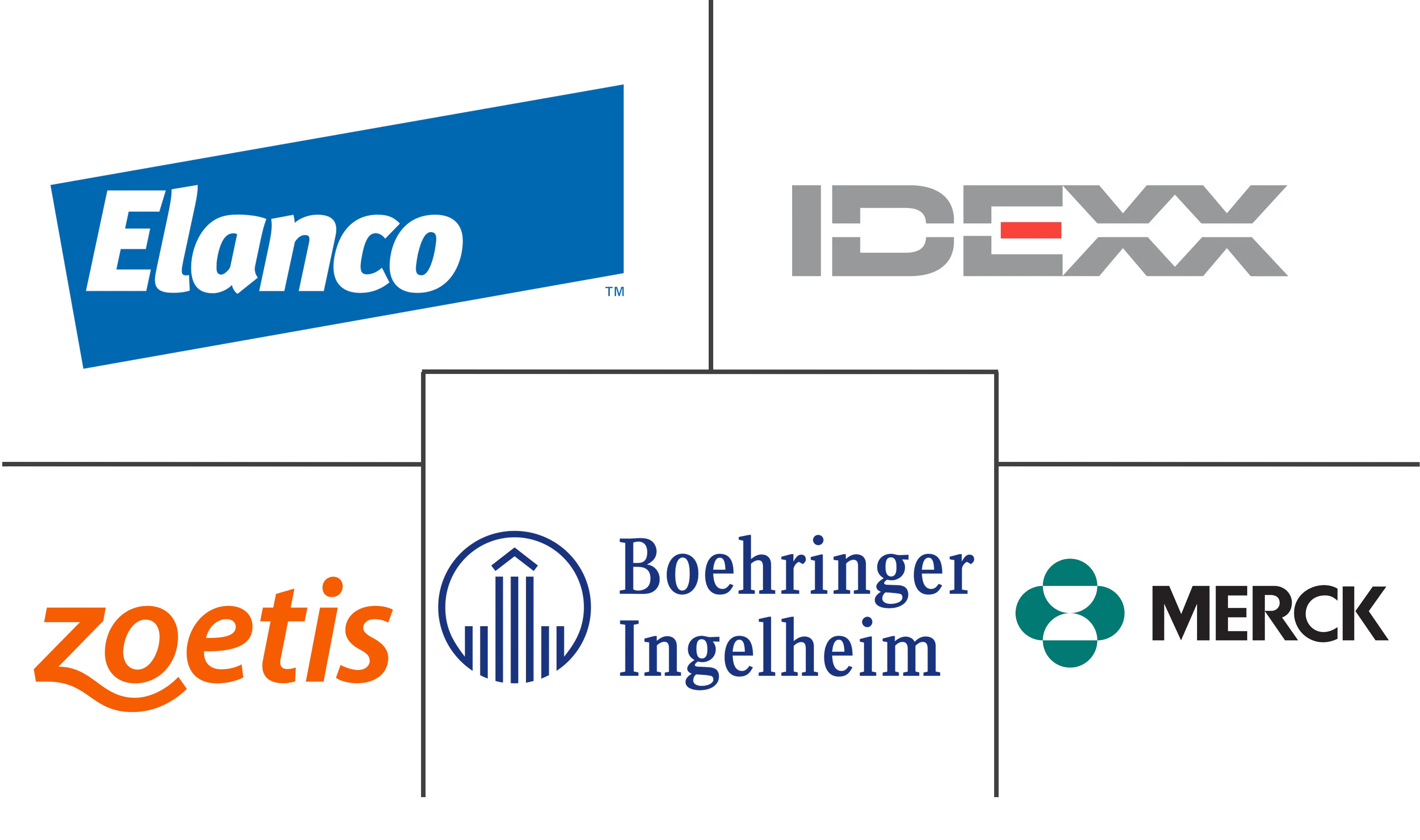
United States Veterinary Healthcare Market Analysis by Mordor Intelligence
The United States Veterinary Healthcare Market is expected to register a CAGR of 5% during the forecast period.
The emergence of the COVID-19 pandemic has impacted the growth of the studied market. The lockdown in the country has affected the supply chain of pharmaceutical products and disrupted the services in veterinary centers and clinics. For instance, according to an article published in March 2021, titled 'Association between Experience of Pet Ownership and Psychological Health among Socially Isolated and Non-Isolated Older Adults', it has been found that socially isolated older adults without dogs were more likely to have lower psychological health than their peers who have or have had a dog in their life during the COVID-19 pandemic. Also, people have experienced some barriers to accessing veterinary care during a pandemic such as limited appointments due to government guidelines and some participants having to access emergency vet services which were more costly than regular visits and check-ups. Similarly, according to a survey by American Veterinary Medical Association, in May 2020, it has been observed that over 30% of the veterinary practices were done using telemedicine and only 20% were seeing emergency-related cases. Thus, COVID has significantly affected the market growth during the pandemic. However, the releasing of COVID-19 restrictions and resuming veterinary services as well as increased vet visits are expected to rise the demand for veterinary healthcare-related products and tests, which in turn is anticipated to propel the market growth during the forecast period.
The Centers for Disease Control and Prevention, recommended veterinary hospitals and clinics prioritize urgent and emergency visits and procedures. Moreover, pet adoptions increased during this pandemic situation. Several animal shelters, non-profit rescue organizations, private breeders, and pet stores observed increased consumer demand. Foster Inc., a non-profit organization, claimed to register more than 1,000% increase in foster applications during the lockdown period in New York, which was the epicenter of COVID-19 cases in the United States.
Certain factors that are propelling the market growth are advanced technology leading to innovations in animal healthcare, increasing productivity at the risk of emerging zoonosis, and increasing initiatives by the government and animal welfare associations.
The rising number of animal adoption in the country is expected to drive market growth. For instance, according to the 2022 statistics published by Best Friends Save Them All, it has been observed that 79 million cats and 108 million dogs were owned in the United States in 2021. Also, the Society for the Prevention of Cruelty to Animals, Los Angeles, reported that the rate of pet adoption doubled in June 2020, with daily adoptions of about 10 to 13 pets per day. The rising adoption of pets is expected to drive the demand for better healthcare facilities and treatments which in turn is anticipated to propel the market growth over the forecast period.
The United States is among the major regions across the world that highly support the healthcare of veterinary animals both in companion animals (e.g. dogs, cats, and horses) and production (e.g. cattle, pigs, sheep, poultry, etc.) of animal species categories.
A large population investing in pet insurance, across the developed markets, is also contributing to the market growth. For instance, as per the North American Pet Health Insurance Association (NAPHIA) State of the Industry Report 2022 Highlights, the total premium volume for pet insurance in the United States was USD 2.591 billion, and 3,979,282 pets were insured in 2021, with an increase of 28.3% as compared to 2020. In addition, as per the same source, California (19.3%), New York (8.4%), and Florida (6.1%) have the highest percentages of insured pets.
In addition, the government is taking various measures to enhance the management of animal healthcare, in terms of diagnosis and treatment. For instance, in September 2021, the Animal and Plant Health Inspection Service of the United States Department of Agriculture (USDA) planned to invest up to USD 500 million to proactively expand and coordinate monitoring, surveillance, prevention, quarantine, and eradication activities to stop the spread of African Swine Fever (ASF). Also, the American College of Veterinary Surgeons funded various projects in 2021, that primarily encourage surgeons to investigate varied topics related to animal health. This is expected to lead to better surgical care for animals.
Furthermore, the advancements of technologies in the animal healthcare sector, have been increasing over the period and have led to the development of smart wearable devices, livestock monitoring systems, electronic recording systems, and approval of new products which are expected to boost the market growth over the forecast period. For instance, in August 2021, Merck Animal Health, United States, launched WHISPER ON ARRIVAL, a precision tool that uses a wide range of variables to identify which cattle may be more susceptible to illness. This information can be used by farmers and veterinarians to plan a strategy for the management of bovine respiratory disease (BRD), one of the most common diseases in beef cattle. Additionally, in May 2020, the United States Food and Drug Administration approved Felix Pharmaceuticals' Enrofloxacin Flavored Tablets, for the treatment of bacterial diseases in pets and domestic animals.
Moreover, in January 2020, Zoetis, a leading animal health company further expanded its poultry vaccine portfolio with the introduction of Poulvac Procerta HVT-ND, a vectored recombinant vaccine for protection against Newcastle and Marek's disease viruses. With the rising number of owners, product approvals, and support from the government, the studied market is expected to grow in the United States over the forecast period.
However, high costs related to animal testing are expected to impede market growth over the forecast period.
United States Veterinary Healthcare Market Trends and Insights
Medical Feed Additives Segment Expects to Register a High CAGR in the United States Veterinary Healthcare Market Over the Forecast Period
The medicated feed additives segment is expected to witness significant growth in the studied market owing to the factors such as the increasing demand for feed additives for various purposes and growing animal health expenditure.
Medical feed additives are essential components that are added to an animal's diet to treat diseases and enhance nutrition. It is as efficient as other administration methods including injection, in-water, and tablets, and is a stress-free, safe way to give veterinary medications. Other medicated feed additives include digestive enzymes, yeast products, organic trace minerals, Omega-3, and Omega-6 fatty acids, and direct-fed microbials (probiotics). These are used to provide particular benefits like better digestion, the absorption of particular nutrients in the animal's digestive tract, support for the aging process, and others.
In addition, the rising expenditures on companion and pet animals by pet owners, increasing use of medicated feed additives, and growing demand for amino acids due to animals' inability to natively generate critical amino acids are expected to boost the demand for medicating feed additives, thereby fueling the segment growth.
Feed additives promote optimum lifetime performance, feed efficiency, animal health, and the welfare of animals. Medical feed additives play an important role in animal nutrition, as livestock producers seek new sustainable and natural ways to enhance performance, improve gut health, diminish and replace antibiotic growth promoters (AGP) in feed, and address consumer demands.
Furthermore, the rising company activities and growing focus on adopting various business strategies such as product launches, mergers, acquisitions, and partnerships to gain a competitive edge in the market are also contributing to the growth of the segment. For instance, in January 2021, the United States Food and Drug Administration approved Huvepharma's Optigrid 45, ractopamine hydrochloride Type A medicated article a feed additive for combination use with other drug feed additive products in the manufacture of Type B and C medicated feeds for promoting weight gain and improving feed efficiency in finishing feedlot cattle. Also, in January 2020, Layn Corp. launched TruGro MAX, a natural additive for animal feed that provides potent antioxidant support, in the United States. Similarly, in January 2020, Kemin Industries launched VANNIX C4, a novel phytogenic feed additive in the United States. The product is a patented formulation of natural, gut-health-enhancing substances developed as a cost-effective alternative for producers to reduce the negative effects of enteric problems on poultry performance.
Hence, owing to the aforementioned factors, it is expected to drive the demand and usage of medical feed additives over the forecast period.

Competitive Landscape
The United States Veterinary Healthcare Market is moderately competitive. The market players are focusing on improved diagnostics techniques for animal care, especially protecting animals from diseases from changing weather conditions. Some of the major players in the market are Boehringer Ingelheim International GmbH, Idexx Laboratories, Elanco Animal Health, Merck & Co. Inc., and Zoetis Inc, among others.
United States Veterinary Healthcare Industry Leaders
-
Elanco Animal Health
-
Merck & Co. Inc.
-
Idexx Laboratories
-
Zoetis, Inc.
-
Boehringer Ingelheim International GmbH
- *Disclaimer: Major Players sorted in no particular order

Recent Industry Developments
- In March 2022, LexaGeneHoldings developed a fully automated rapid pathogen testing device LexaGenes MiQLab System and announced advancements to its sample preparation cartridge for processing complex samples. This system s designed to process liquid samples from companion animals used in the diagnosis of infections such as urinary tract infections (UTIs) and skin infections.
- In January 2022, Covetous launched Covetrus Pulse, an innovative cloud-based veterinary operating system (VOS) that seamlessly connects veterinarians to the technology they need to manage their practices freeing up more time to spend with the animals in their care.
United States Veterinary Healthcare Market Report Scope
As per the scope of the report, veterinary healthcare can be defined as the science associated with the diagnosis, treatment, and prevention of diseases in animals. The veterinary healthcare market comprises therapeutic and diagnostic products and solutions for companion and farm animals. Companion animals can be tamed or adopted for companionship or as house/office guards, and farm animals are raised for meat and milk-related products. Companion animals include canines, felines, and equines. Farm animals include bovine, poultry, and porcine. The United States Veterinary Healthcare Market is segmented by Product (Therapeutics and Diagnostics), Animal Type (Dogs and Cats, Horses, Ruminants, Swine, Poultry, and Other Animals). The report offers the value (in USD million) for the above segments.
| Therapeutics | Vaccines |
| Parasiticides | |
| Anti-infectives | |
| Medical Feed Additives | |
| Other Therapeutics | |
| Diagnostics | Immunodiagnostic Tests |
| Molecular Diagnostics | |
| Diagnostic Imaging | |
| Clinical Chemistry | |
| Other Diagnostics |
| Dogs and Cats |
| Horses |
| Ruminants |
| Swine |
| Poultry |
| Other Animals |
| By Product | Therapeutics | Vaccines |
| Parasiticides | ||
| Anti-infectives | ||
| Medical Feed Additives | ||
| Other Therapeutics | ||
| Diagnostics | Immunodiagnostic Tests | |
| Molecular Diagnostics | ||
| Diagnostic Imaging | ||
| Clinical Chemistry | ||
| Other Diagnostics | ||
| By Animal Type | Dogs and Cats | |
| Horses | ||
| Ruminants | ||
| Swine | ||
| Poultry | ||
| Other Animals | ||
Key Questions Answered in the Report
What is the current United States Veterinary Healthcare Market size?
The United States Veterinary Healthcare Market is projected to register a CAGR of 5% during the forecast period (2025-2030)
Who are the key players in United States Veterinary Healthcare Market?
Elanco Animal Health, Merck & Co. Inc., Idexx Laboratories, Zoetis, Inc. and Boehringer Ingelheim International GmbH are the major companies operating in the United States Veterinary Healthcare Market.
What years does this United States Veterinary Healthcare Market cover?
The report covers the United States Veterinary Healthcare Market historical market size for years: 2019, 2020, 2021, 2022, 2023 and 2024. The report also forecasts the United States Veterinary Healthcare Market size for years: 2025, 2026, 2027, 2028, 2029 and 2030.
Page last updated on:
United States Veterinary Healthcare Market Report
Statistics for the 2025 United States Veterinary Healthcare market share, size and revenue growth rate, created by Mordor Intelligence™ Industry Reports. United States Veterinary Healthcare analysis includes a market forecast outlook for 2025 to 2030 and historical overview. Get a sample of this industry analysis as a free report PDF download.



